

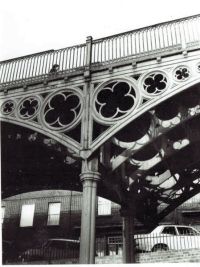 Amongst all the products that Garton & King and its predecessors manufactured there is one category that it seems that I have completely overlooked and it was only when a black and white photograph came into my possession recently did it make me realise that, apart from a mention of the Gordon Lamp (see Monuments page) the subject of Street Lights and Lamps in general had been all but overlooked and forgotten.
Amongst all the products that Garton & King and its predecessors manufactured there is one category that it seems that I have completely overlooked and it was only when a black and white photograph came into my possession recently did it make me realise that, apart from a mention of the Gordon Lamp (see Monuments page) the subject of Street Lights and Lamps in general had been all but overlooked and forgotten.
I have now hunted through my files and photo albums and this new page is the result. I have reproduced the image that set the ball rolling here, the first one on the page. To those of you familiar with Exeter you will immediately recognise the structure as the Iron Bridge that leads from the bottom of North Street towards St David’s and Mount Dinham, across a deep valley. At first glance there is nothing remarkable about the image apart from it being particularly good on detail. What I noticed is that the capping on the railings to the left of the support is partially missing and the stanchion had been damaged and repaired with additional brackets.
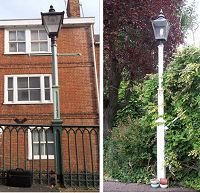 I believe I am right in saying that back in the 1960s a traffic accident on the bridge caused one of the ten matching lamp standards that are placed at regular intervals on the bridge and incorporated in the railings, to sustain damage and it was beyond repair. The left hand image is of one of the present Lamp Columns. Garton & King cast a replacement, in fact two; one for the bridge and the other for our home in Spicer Road and which is shown in the right hand image. The property has since been demolished and No 10 Spicer Road is now Magdalen Court. The lamp post somehow ‘disappeared’ during the redevelopment and I am almost sure it has cropped up in a property in West Hill, Ottery St Mary. It was supposed to remain and be incorporated in the new development. I’ll leave it to your imagination as to how it ended up in West Hill!
I believe I am right in saying that back in the 1960s a traffic accident on the bridge caused one of the ten matching lamp standards that are placed at regular intervals on the bridge and incorporated in the railings, to sustain damage and it was beyond repair. The left hand image is of one of the present Lamp Columns. Garton & King cast a replacement, in fact two; one for the bridge and the other for our home in Spicer Road and which is shown in the right hand image. The property has since been demolished and No 10 Spicer Road is now Magdalen Court. The lamp post somehow ‘disappeared’ during the redevelopment and I am almost sure it has cropped up in a property in West Hill, Ottery St Mary. It was supposed to remain and be incorporated in the new development. I’ll leave it to your imagination as to how it ended up in West Hill!
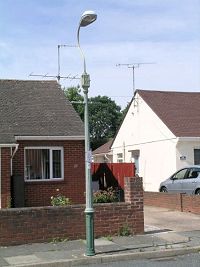 Apart from these ten rather special lamps on the Iron Bridge – only one being made by Garton & King, there are in fact a great many cast iron lamp standards within the city, the majority of which are in excess of 100 years old. Over time they have transitioned from being Gas Burning to Electric Light and the style of the lantern tops have been altered and redesigned. Early conversions were fitted in the 1940s and later with Mercury Vapour light bulbs (those were the ones that gave human skin a sickly hue!) then Sodium Bulbs (SOX & SON) and maybe some nowadays sport an LED type of light.
Apart from these ten rather special lamps on the Iron Bridge – only one being made by Garton & King, there are in fact a great many cast iron lamp standards within the city, the majority of which are in excess of 100 years old. Over time they have transitioned from being Gas Burning to Electric Light and the style of the lantern tops have been altered and redesigned. Early conversions were fitted in the 1940s and later with Mercury Vapour light bulbs (those were the ones that gave human skin a sickly hue!) then Sodium Bulbs (SOX & SON) and maybe some nowadays sport an LED type of light.
Lamp standards or ‘columns’ unfortunately are somewhat awkward to photograph being tall and thin. The image (right) of the column in the pavement in front of the Bungalows (Whipton, Exeter) is by Taylor & Bodley as is the left hand in the next image (below left) is one located at Follet Road, Topsham. The central image which includes a phone box and a letter box is of a G & K lamp standard in Powderham Crescent, Exeter. The close up (below right) confirms another by Garton & King in Marlborough Avenue. This style of lamp column is a pretty standard design and can be seen throughout the UK. In Exeter they were cast by all manner of Foundries including G & K, Parkyn, Willey, & Co, Taylor & Bodley. & the large Revo Company located in Tipton, West Midlands (who designated the design as the ‘Groveland’).
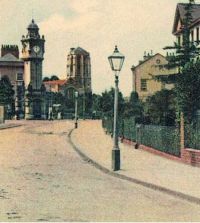 This particular design has been around since the late 1890s as the 1907 tinted postcard image on the right shows. The location is New North Road, near to where Veitch’s Nurseries were located, and the lantern on top is a typical gas burning light. With the march of progress they were all eventually replaced or converted to electric though some gas lights survived and were still illuminating the streets of Exeter in the 1950s.
This particular design has been around since the late 1890s as the 1907 tinted postcard image on the right shows. The location is New North Road, near to where Veitch’s Nurseries were located, and the lantern on top is a typical gas burning light. With the march of progress they were all eventually replaced or converted to electric though some gas lights survived and were still illuminating the streets of Exeter in the 1950s.
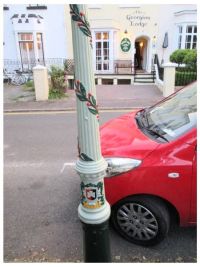 One distinctive style of lamp column that Garton & King had the drawings for, were those columns that flaunted the City Crest and the motto Semper Fidelis. In 2003 there were still at least 12 in their original locations, often outside former Mayors’ houses. Most were cast by Parkin but some by G & K. The ones that are still in situ are often in a sorry state but the one in Bystock Terrace, together with other cast iron columns in St David’s, have received in recent years a bit of a spruce up.
One distinctive style of lamp column that Garton & King had the drawings for, were those columns that flaunted the City Crest and the motto Semper Fidelis. In 2003 there were still at least 12 in their original locations, often outside former Mayors’ houses. Most were cast by Parkin but some by G & K. The ones that are still in situ are often in a sorry state but the one in Bystock Terrace, together with other cast iron columns in St David’s, have received in recent years a bit of a spruce up.
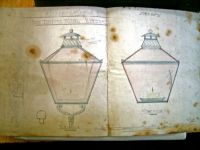 Apart from Street Lighting the Company, in Victorian times particularly, were involved in Interior Lighting. Another drawing refers to an order by Sidney Herberte-Basing Esq, New Theatre Royal. Sidney Herberte-Basing was the manager of the first Theatre Royal in Longbrook Street, the building where the tragic fire occurred in 1887. This theatre opened in October 1886, following the fire at the second Bedford Circus theatre in February 1885. At the bottom of the drawing is a scale, and what could be RWT... as a signature, but not really legible. The left drawing is ‘Elevation’ and the right ‘Section’. The candle is standing in a saucer with the word ‘Water.’ (Detail by Dick Passmore.)
Apart from Street Lighting the Company, in Victorian times particularly, were involved in Interior Lighting. Another drawing refers to an order by Sidney Herberte-Basing Esq, New Theatre Royal. Sidney Herberte-Basing was the manager of the first Theatre Royal in Longbrook Street, the building where the tragic fire occurred in 1887. This theatre opened in October 1886, following the fire at the second Bedford Circus theatre in February 1885. At the bottom of the drawing is a scale, and what could be RWT... as a signature, but not really legible. The left drawing is ‘Elevation’ and the right ‘Section’. The candle is standing in a saucer with the word ‘Water.’ (Detail by Dick Passmore.)
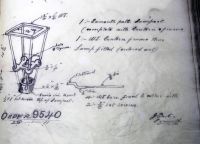 The Order Book gives us a requirement dated 26 January 1911 for an Exmouth Style Column with a lantern as shown; the style of lamp post is probably similar to the 3rd image from the top on this page.
The Order Book gives us a requirement dated 26 January 1911 for an Exmouth Style Column with a lantern as shown; the style of lamp post is probably similar to the 3rd image from the top on this page.
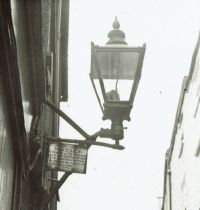 The black and white image of an Exeter Gas Lamp has an enamelled notice attached to it headed Exeter Gas Light and Coke Company reminding persons that there is a 10/- (50p) reward for anyone giving information leading to conviction of any persons for breaking glass on any Public Lamps!
The black and white image of an Exeter Gas Lamp has an enamelled notice attached to it headed Exeter Gas Light and Coke Company reminding persons that there is a 10/- (50p) reward for anyone giving information leading to conviction of any persons for breaking glass on any Public Lamps!
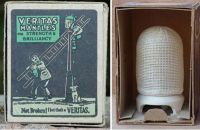 Gas lighting in homes and shops was commonplace in the 1900s but by the end of WW2 was very much a thing of the past. Caravans of the 50s and 60s had gas (bottle) lighting and Woolworth’s main store in Exeter, located on the former site of G & K and Pinder & Tuckwell’s premises at 191 & 192 High Street still had gas lighting installed for use in emergencies in the 1950s.
Gas lighting in homes and shops was commonplace in the 1900s but by the end of WW2 was very much a thing of the past. Caravans of the 50s and 60s had gas (bottle) lighting and Woolworth’s main store in Exeter, located on the former site of G & K and Pinder & Tuckwell’s premises at 191 & 192 High Street still had gas lighting installed for use in emergencies in the 1950s.
Originally ‘gas’ was Coal Gas. Coal gas is a combination of hydrogen, methane, carbon monoxide and sulphur and areas needed to be well ventilated to avoid the deadly carbon monoxide.
G & K retailed, in Victorian times, all manner of gas lights and fittings and were one of the first commercial premises in Exeter to install Gas Lighting. See below the colour tinted drawing and some suggestions for chandeliers from the G & K Catalogue for 1900.
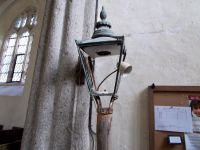 The last colour image (right) is taken of a lamp in Higher Ashton Church and I could not resist adding it to this page. It demonstrates a novel approach on how to convert a former Gas Lamp to operate on Electricity. You do, however, need a 13amp socket nearby!
The last colour image (right) is taken of a lamp in Higher Ashton Church and I could not resist adding it to this page. It demonstrates a novel approach on how to convert a former Gas Lamp to operate on Electricity. You do, however, need a 13amp socket nearby!
To the many residents of East Devon the Knowle was, from 1969, the home of East Devon District Council; however they relocated to new premises in Honiton in 2019. From 1882 up until 1968 it was a Hotel, marketed as the ‘Friendly Hotel’. It is the earlier period when the property was in the hands of the Thorntons (1867 – 1882) and in particular the period from 1867 when Richard Napoleon Thornton was the owner up until his death on the 28th May 1876 and the works he planned that this page is especially interested in. The History of the Knowle is contained in a publication published in 2013 by the Sid Vale Association for Sidmouth Museum ISBN 978-0-9512704-5-5 ‘The Knowle, a Stately Pleasure Dome’.
 Having set the scene you might well enquire as to what involvement Garton & King had in the Knowle and the simple answer is ‘illumination’. Not to the property but to an entrance to the estate. To quote from the above mentioned publication, “In 1872 plans were passed for an alteration to the entrance to Knowle, closing the original entrance and fixing the gates where those of Ayshford had formerly stood. At the same time pushing back the wall to widen the road and placing and maintaining two lamps on the Gate Piers.”
Having set the scene you might well enquire as to what involvement Garton & King had in the Knowle and the simple answer is ‘illumination’. Not to the property but to an entrance to the estate. To quote from the above mentioned publication, “In 1872 plans were passed for an alteration to the entrance to Knowle, closing the original entrance and fixing the gates where those of Ayshford had formerly stood. At the same time pushing back the wall to widen the road and placing and maintaining two lamps on the Gate Piers.”
Currently there are two entrances, one at the junction of Broadway and Station Road and the other to the south at the junction of Knowle Drive and Station Road; it is the lower entrance that we are interested in. Of the two lamps referred to above it seems but one (in a rather sorry state I must add) remains on the northern side. Regrettably the one that would have been placed on the southernmost pier of the gateway has been removed but by whom and when I do not know, certainly before 2008. There are now no gates.
Garton & King were commissioned to provide the lanterns and I have attached the Drawing. They were originally illuminated by gas, Sidmouth’s second Gas Works having been opened in 1863. The drawing states that the lanterns were for the New Ayshford Gateway (Knowle Drive entrance) and were affixed to the Ham Hill Stone Capping of the pillars. I have no records of the number of lanterns ordered, there are 4 pillars. The Knowle Book states two but does not indicate any evidence for this number.
It is possible to go back in History with Google Maps and an image dated April 2011 best shows the entrance to Knowle Drive. It excludes the out-of-character blockwork erected later, presumably by the owners of the southern lodge, which spoils the original design.
I have included a close up image of the surviving lantern, this image is again courtesy of Google Maps and is 2018 imagery. When lockdown allows I will endeavour to take a better image of the lamp from a closer position.
Another Drawing exists in our archives together with the drawing of the Lantern that refers to some New Gates. This drawing is also undated but the dimensions indicates that they are intended for the same entrance as the gates measure 10 foot 9 inches in width and when lockdown permits I shall endeavour to measure the gap between the inner pillars at the Ayshford / Knowle Drive entrance. The text accompanying the drawing reads:- “To provide and hang a pair of folding gates of wrought iron with cast iron palisade points screwed on and ornaments. To have steel pivots working in proper sockets leaded into blocks of granite. To have a copper warded lock and 2 keys to secure, also a bolt, socket for the bolt and stop for the gate and proper latch. The scantlings for the iron as figured. To have catches hinged let into granite to hold the gates when open. The Ironwork to be painted twice with red lead before exposure and then with good white lead and or (?) paint the colour as will be directed.”
It is hoped, if ever an image of the gates in place is discovered and can be added to this website then this paragraph on The Knowle Gates will be transferred to the Iron Gates page.
February 2021
Top of page
See also:
Monuments — The Mixed Bag — Iron Gates
Third Rail, Hand Rails, Finials & Freebies
Railings
Sitemap / Contents